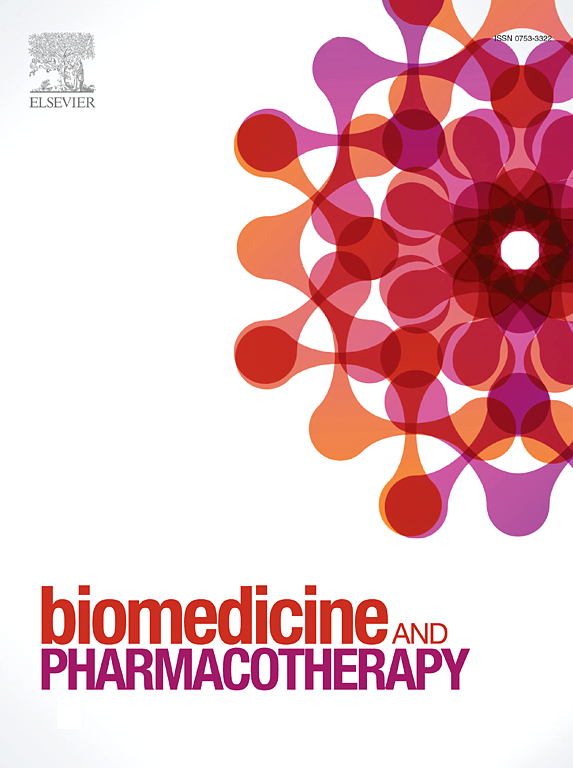在喂食高热量食物的中年大鼠中,口服芹菜素可以预防与肥胖相关的肌肉萎缩,但不能预防肥胖本身
IF 7.5
2区 医学
Q1 MEDICINE, RESEARCH & EXPERIMENTAL
引用次数: 0
摘要
肥胖是一个日益严重的全球健康问题,在老龄化过程中影响着个人。增加组织NAD+ 水平的类黄酮,如芹菜素(Api),被提议用于治疗肥胖和与年龄相关的疾病。因此,本研究旨在通过高热量饮食(HCD)诱导肥胖的中年大鼠,在这种情况下提供Api的初步临床前证据。将47只15月龄雄性Wistar大鼠分为标准饲粮组(SD)和HCD组(Api为50 mg/kg)和未给药组(载药组),外加载药对照组。肥胖诱导和治疗干预同时进行,为期88天。分析了生物特征、心脏、脂肪、肌肉和血液生化参数。HCD后88天,大鼠出现高血糖、高甘油三酯血症、内脏和皮下脂肪增加以及心脏肥厚,表明肥胖和相关疾病(p <; 0.05)。这些大鼠的腓肠肌表现出体积减小、肌细胞变小和纤维化(p <; 0.05),表明肌肉减少症可能由肥胖引起或加重。同时,预防性Api治疗不能预防肥胖,也不影响关键的脂肪组织褐变基因、心脏氧化应激标志物或sirtuin和CD38水平。然而,除了提高hcd喂养大鼠的p70S6K水平外,它还减轻了肌肉损失和萎缩(p <; 0.05)。这些临床前结果表明,尽管Api可能不能预防一些hcd引起的紊乱,但它可能通过p70S6K合成代谢信号通路,在中年大鼠中减轻年龄和肥胖相关的萎缩。为了支持临床翻译,特别是在骨骼肌减少症亚型中,需要进一步的机制和治疗研究来阐明其对骨骼肌的作用。本文章由计算机程序翻译,如有差异,请以英文原文为准。
Oral apigenin prevents obesity-related muscular atrophy, but not obesity itself, in middle-aged rats fed a high-calorie diet
Obesity constitutes a growing global health concern, affecting individuals during the aging process. Flavonoids that increase tissue NAD+ levels, such as apigenin (Api), are proposed for the treatment of obesity and age-related diseases. Thus, this study aimed to provide initial preclinical evidence of Api in this setting using middle-aged rats induced to obesity by a high-calorie diet (HCD). Forty-seven 15-month-old male Wistar rats were assigned to five groups: standard diet (SD) or HCD, each with (Api at 50 mg/kg) or without treatment (vehicle), plus vehicle control group. Obesity induction and therapeutic intervention were conducted concurrently for 88 days. Biometric, cardiac, adiposity, muscular, and blood biochemical parameters were analyzed. Eighty-eight days post HCD rats had hyperglycemia, hypertriglyceridemia, increased visceral and subcutaneous fat, and heart hypertrophy, indicating obesity and related disorders (p < 0.05 for all). The gastrocnemius of these rats exhibits reduced mass, smaller myocytes, and fibrosis (p < 0.05), indicating sarcopenia, likely caused or worsened by obesity. In parallel, preemptive Api treatment failed to prevent obesity and did not affect key adipose tissue browning genes, cardiac oxidative stress markers, or sirtuin and CD38 levels. However, it mitigated muscle loss and hypotrophy, in addition to elevating p70S6K levels in HCD-fed rats (p < 0.05 for both). These preclinical results suggest that although Api may not prevent some HCD-induced disturbances, it may attenuate age- and obesity-related atrophy via p70S6K anabolic signaling in middle-aged rats. To support clinical translation, particularly in sarcopenia subtypes, further mechanistic and therapeutic investigations on Api are required to elucidate its effects on skeletal muscle.
求助全文
通过发布文献求助,成功后即可免费获取论文全文。
去求助
来源期刊
CiteScore
11.90
自引率
2.70%
发文量
1621
审稿时长
48 days
期刊介绍:
Biomedicine & Pharmacotherapy stands as a multidisciplinary journal, presenting a spectrum of original research reports, reviews, and communications in the realms of clinical and basic medicine, as well as pharmacology. The journal spans various fields, including Cancer, Nutriceutics, Neurodegenerative, Cardiac, and Infectious Diseases.

 求助内容:
求助内容: 应助结果提醒方式:
应助结果提醒方式:


